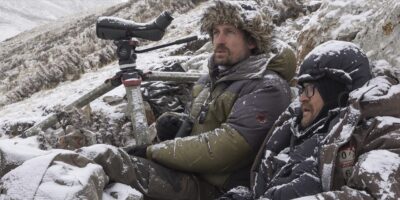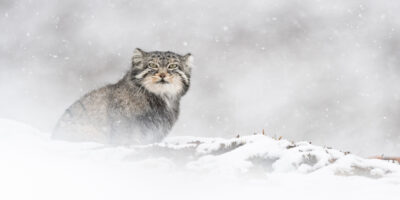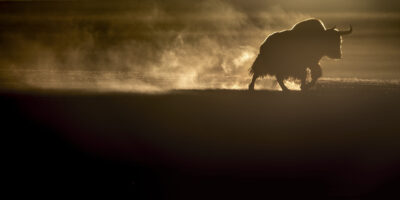On December 22 we’ll open the acclaimed French wildlife documentary The Velvet Queen at the Royal in West L.A., with possible expansions to our Pasadena, Encino, Claremont, Newhall and Glendale theaters on January 7. In Variety, film critic Guy Lodge wrote “Two French adventurers travel the Tibetan Highlands in search of the elusive snow leopard, but Marie Amiguet’s quietly spellbinding doc is more about the chase than the quarry.” In Moveable Fest, Steven Saito wrote that co-director Marie “Amiguet get[s] at something even scarcer and more exquisite than what the two men are chasing.”
The Velvet Queen co-director and photographer Vincent Munier was interviewed about his experience:
Q: Why has the snow leopard been the main focus of your thoughts and your journeys over the past few years?
A: I’m still a big kid who lives off his dreams and images of mythical animals. I discovered this leopard in the adventure stories of American biologist George B. Schaller. He had filmed it in Chitral, in Pakistan, in the 1970s. But when I went to Tibet for the first time, in 2011, I wasn’t very convinced I would have a chance of seeing it. On the other hand, I knew I would see other species that were equally enigmatic. And to start with, I spent a month without seeing it — just some tracks — but it was fascinating to know that it was there. I was first attracted to these high plateaus by the wild yack, a totem animal from another era, which was probably around at the same time as woolly rhinos or mammoths. Like the musk ox in the Arctic. Deep down, the leopard was a pretext. An extravagant pretext, but a pretext all the same.

Q: What made you come back on its tracks so often?
A: As with the Arctic, I like to return to the same places… I like to discover them at my own pace, over time, and often alone. It’s a great satisfaction to slowly learn to uncover the secrets that surround wild animals, by imagining them, tracking them, and observing them! I’ve effectively always preferred to spend several years focussing on one subject, rather than flitting from one to another: fleeing orders and following my instinct. With regards to Tibet, I must have been there eight times, at first to shoot photos and then for a book. Then, I got this desire to film, with a small team of two to three people at most, to avoid disturbing the wildlife and to be able to remain adaptable and flexible in this complex high-altitude environment. Léo-Pol Jacquot has been working with me for eight years, mainly in the office. I was delighted to get him away from his screens a bit and take him up there! He has practically no on-terrain experience and I was astonished by his ability to adapt. Marie Amiguet brought a fresh look at the place, a particular sensitivity… and I appreciated her leopard-like discretion. Her mission was to follow us whilst remaining invisible, to film us without anything being staged, so that we could be as close to reality as possible. That method brings its share of awkwardness and technical shortcomings, but also a certain amount of sincerity in the moments captured. The aim was to precisely capture the emotions we were feeling.

Q: Why is it that the last two times you decided to travel with a writer?
A: To get a broader vision. It’s no longer sufficient for me to take my fill of the beauty I encounter and these living dreams. I want to share these experiences, to draw attention to the urgency of putting aside our intense anthropocentrism, to end the devastating hegemony of the human species over all others. I am deeply scarred by the destiny that awaits all these animals that are pushed into ever-decreasing areas because of us! And it’s difficult to portray that dimension using only images, particularly when you’ve chosen to show beauty rather than devastation. To emphasize the wonder that I want to portray with my photographs, I felt that a well-composed, engaged written presentation was necessary.

Q: What made you choose Sylvain Tesson?
A: Sylvain and I had already bumped into each other several times and he’d mentioned he’d like to accompany me on my observations. I knew his adventure tales but I was particularly taken with his book Sur les Chemins Noirs. You could feel an ecological thread running through it. So, I naturally invited him to bring my adventures to a close with a book using his texts and this film. As is often the case, I strive to build bridges: to convey wonder, follow nature’s slow pace that you become completely steeped in as the hours and observations pass. So the aim was to film our exchanges around a common dream by using the wildlife images brought together during my preceding adventures up there. At the same time, came the idea of proposing a beautiful object related to that, an album whose photos would have captions composed by the writer. That’s my artistic side. I like to follow every stage at my own pace, so I can be as close as possible to what I really want to share, with no constraints and no pressure.

Q: Vincent, you who are often used to doing your wildlife-watching alone, this time you had more people than ever before with you: guides, a writer, a director, and an assistant director following in your steps. How did that change the way you work?
A: I got myself into a different mindset. And we were rarely all together at the same time. One or two Tibetan friends stayed on the base camp (in the bottom of a valley, by a river), that we travelled out from for several days, into a landscape that I already knew a little thanks to the time I’d spent there previously. After that, we’d split up to work in more discreet pairs.
Q: Was your encounter with this beauty guaranteed?
A: The highpoint of this project was that it was like a planetary alignment, everything just fell into place. To begin with, there was no foregone conclusion that this combination would work out. And there was absolutely no guarantee that Sylvain would effectively end up seeing this leopard. And then, during the very last days, she was there! When I got out from beneath my duvet in the cave, and I saw her eating her prey that she’d killed the day before, it was just an incredible moment! That’s something you can’t stage in advance, of course.
Q: Talking of lucky planetary alignments, it would seem that also brought you a great surprise for the film’s music.
A: It was stunning! We were incredibly lucky to work with Warren Ellis, an extraordinary artist, whose minimalist and enchanting music I adore. It really echoed the vast wild landscapes and magical apparitions of the animals I encountered in Tibet. I had dreamed of being able to work with him one day on one of my films. I thought he was totally inaccessible, but, in spite of his massively busy schedule, he accepted to compose an original score for our leopard! And our exchanges during that work were extremely interesting and meaningful. I discovered him to be a sensitive and kind man. In spite of the fact that we work in very different environments, we found that we shared a lot of our influences. Even though he was supposed to go to Brighton to record his poetry album with Marianne Faithfull, he managed to make time to compose this score. And he brought in his former partner Nick Cave. Nick sings Sylvain’s words! Finishing the film on their voice and music was something I’d never dared hope for!
Q: On a more down to earth matter: You’ve already tested the comforts of Chinese jails in the past when you were out looking for leopards. Did you travel less hazardous administrative routes this time?
A: Astonishingly, yes. Yet, in these regions, the police are on the lookout. They are all over the place and carry out constant checks. You’re not allowed to photograph the poverty of the nomads, Chinese installations, and so on. The police force is probably the Chinese State’s largest employer in Tibet. And effectively, during one of my previous trips, when I had discovered the perfect place to watch out for the leopard, I was arrested by the police who accused me of poaching. It was totally absurd and very violent. In fact, I thought I’d been blacklisted and wouldn’t be allowed back. The exceptional presence of Europeans can create a veritable climate of paranoia in certain sectors. Luckily, we didn’t have any problems the last two times.
As a side story, the pictures of the leopard during the film’s closing credits, when we hear Nick Cave’s moving voice, were taken thanks to an automatically triggered camera. I’d placed it on the prey it had recently killed and, in between times, I’d been taken in by the police who kept me several days for a brutal interrogation. I got my first pictures of the animal without seeing it!
Q: Tell us about your first encounter with the snow leopard.
A: What a moment that was! But first and foremost, it was tracking it that was fascinating. Looking for its tracks, reading the clues, spending whole days with my binoculars glued to my eyes. Tracking it down is so exciting! Deep down, it has this slightly devilish side to it, constantly watching us without us being able to see it. It obliges us to behave a little like it does. We have to hide, camouflage, and above all, not be intrusive… that’s what it brings to us. The first time, there was this slow crescendo. First, there were old tracks, then fresh tracks, a crow calling out (which meant there may be a predator around), a change in weather (which often leads animals to change location)… and as I was spending hours and hours looking through the binoculars, it suddenly appeared in my field of vision. It went past without seeing me! It was like a perfect appearance on screen in a wildlife film. I was even more satisfied as I hadn’t disturbed its movements.
Q: The last trip you made also provided you with a new encounter: the Tibetan bear. Yet you didn’t seem to believe it would happen.
A: Effectively, that was another crazy story. The Tibetans are a little scared of this bear. I’d heard about quite a few fights up there between nomads and bears. But it seemed very improbable that I’d get a chance to observe it. It’s so cold up there. What could they possibly find to eat? They are mainly herbivores, after all! That’s what’s so wonderful about this passion. Nothing is planned, you go from surprise to surprise.
Q: Over the years, with your work, you’ve accumulated a wealth of in-depth knowledge about nature and its inhabitants. But does your instinct also play a role in your decisions with regards to where to go, where to lie in wait, or whether to press on?
A Yes. A huge role. I really believe in the notion of instinct. It’s difficult to describe the role your body plays at those moments in the way you react and the choices you make. Your whole being soaks everything up. All of your senses are brought into play. It’s as if you resonate with the space around you and the living elements in it. Your emotions are literally heightened, and your animal element can finally express itself. Yet, there are regular failures — and that’s a good thing! Failure allows us to understand how vulnerable we are out there.
Q: You say yourself in the film: “I don’t work like a photojournalist, showing what’s wrong with nature.” But isn’t showing only its beauty tantamount to drawing up an inventory of what will soon disappear?
A: That’s sadly true! And I’m not equipped to place my cameras where things are harsh or dark, or where horror has prevailed. In fact, I take my hat off to those who are capable of dealing with that. Naturally, I tend to live off poetry and beauty, even when it’s extremely vulnerable, and it would be really hard for me to only be the witness of ecological catastrophes.
Q: You have often had to deal with very harsh weather conditions. That’s probably not by pure chance.
A: The Arctic, the Antarctic, and Tibet are the three zones that attract me for a number of reasons. I have always liked cold lighting and the animals that live in these hostile conditions. On top of that, because of that extreme harshness, man is less present and the link to wildlife is much clearer. In Tibet, there’s also a very tense geopolitical dimension. There are very few visitors to the sites and its wildlife such as the Tibetan fox, the Tibetan antelope, and the manul remain largely unknown.
Q: For a few years, you’ve been making more films than you have taken photographs. Why is that?
A: When the filming option was put on our cameras about ten years ago, I simply started to use it more and more often. It got to the point where, in Asturias, where I recently made a film on bears, I hadn’t taken any photos at all. I feel that moving images are a better way to portray emotions. It’s exciting being able to integrate sound, too, which echoes the landscape, its ambiences, and its resonances. But a film is also much longer and much harder to make.
Q: After having crossed the leopard’s path several times, do you still dream of it, today? What does it represent for you?
A: The first encounter is inevitably unforgettable. Like all the major first times: with the Eurasian lynx at home in France, that I waited for, for fifteen years, after setting up camp a number of times… I would hear it yowling, but never see it! And finally, the day it appears, you’re finally within reach of something supreme, that’s haunted you for a long time. In the same way, I feel haunted by the memory of the ghostly presence of the first pack of white wolves I observed in the Canadian High Arctic. You’re so obsessed with these visions that you end up wondering if they are fantasies or reality. And there’s not just the image! There are the smells, the noises. All of that permeates you, permanently. Something outside us lodges inside of us, setting us in motion. Like the very first roe deer that I photographed when I was twelve years old, and that changed my life, dramatically. That’s the effect that the snow leopard still has on me, today.
About Vincent Munier: Since 2011, Munier has spent several months in Tibet to bring back precious images of this world that is poised between land and sky. A lover of wild open spaces and of extreme travel, he chose photography as a tool to convey his dreams, his emotions, and his encounters. Today, his pictures are exhibited in galleries in France and abroad. Vincent Munier founded the Kobalann publishing company and today, he is the author of a dozen books, including Arctique (2015) and Tibet, Minéral Animal (2018). In 2019, with Laurent Joffrion, he co-directed the film Ours, Simplement Sauvage (Kobalann Productions / France TV Studio).
